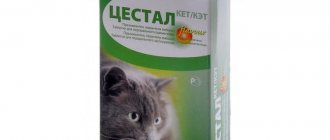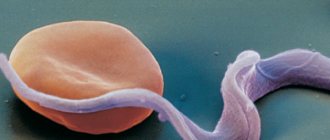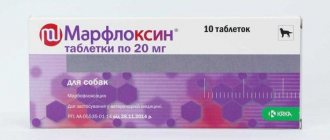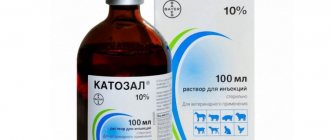Description of the disease
A cat’s liver is an organ with a complex structure and functionality that has not yet been fully studied by specialists. However, it plays a major role in the body in metabolism, removal of toxins, energy accumulation and bile synthesis.
Without a healthy liver, the normal functioning of the entire body is impossible, and any failure in the functioning of this vital organ will invariably lead to disturbances in other systems and organs.
What is hepatosis and how can it be dangerous for a cat? It turns out that this disease is nothing more than the loss of the ability of liver cells to function normally due to their degeneration and dystrophy, as a result of which the animal develops symptoms reminiscent of signs of hepatitis.
However, in contrast to the latter, with hepatosis there are practically no signs of inflammatory processes in the liver.
There are two types of hepatosis:
- Fatty degeneration. With it, previously healthy liver cells degenerate into adipose tissue.
- Amyloidosis of the liver. Its cause is a metabolic disorder when a “harmful” protein, amyloid, is produced and deposited in the liver.
Important!
The most common form of hepatosis in cats is fatty degeneration, which can occur both acutely and chronically.
Causes
Saving on quality food, an unbalanced diet, a lack of vitamins and minerals, intoxication and helminth damage - all this causes a strong blow to the liver. Individually or together, these factors suppress the healthy activity of the organ, aggravating the situation and making it susceptible to disease.
Hepatosis in cats is caused by the following reasons:
- intoxication of the body with poisons (especially plant poisons after chewing grass), chemicals, medications (spoilt food with mold fungi getting into the stomach is common);
- sudden changes in diet (for example, a rapid transition from natural products to feed);
- changing the constantly consumed brand of food;
- hypervitaminosis (excess of vitamins, minerals);
- obesity;
- diabetes;
- infectious viral processes in the intestines;
- pancreatitis;
- malfunction of the thyroid gland;
- lack of vitamin B12;
- diseases of the liver, gall bladder (cholangitis, blockage of ducts, pathologies in the portal vein system).
The main place in the list of provoking factors is occupied by low-quality feed. Unscrupulous manufacturers include harmful additives in their ingredients, and buyers, trying to save money, are increasingly buying dubious, untested products.
Urethrostomy
Keratitis
Glaucoma
Fatty degeneration is caused by prolonged fasting, stress, and malignant neoplasms of internal organs. Obese cats over 10 years of age are susceptible to pathology. Hepatosis in young cats is idiopathic in nature, when the exact cause cannot be determined.
Symptoms
The main feature and greatest danger of hepatosis in cats is that its signs often appear only when pathological changes in the liver have already become irreversible.
After this, they began to develop so rapidly that even the most efficient and responsible owner simply does not have time to save his cat, since sometimes he does not even take it to the veterinary clinic.
However, if you are attentive to your pet and notice the slightest changes in its condition, then there is a chance to catch hepatosis at one of its early stages, which significantly increases the chances of life and even recovery for the pet.
Often, when hepatosis is just beginning, the cat behaves differently than usual: he sleeps for a long time, drinks a lot, and he may also have intestinal upset.
Later, a yellowish coloration of the mucous membranes appears and, as a rule, soon after this the general condition of the cat deteriorates so much that it may even fall into a coma. At this stage, hepatosis is already very difficult to treat and very often it ends in the death of the pet.
Reference!
The manifestation of symptoms depends primarily on the form of the disease: fatty or amyloidosis.
Acute fatty hepatosis, which often occurs rapidly, is characterized by:
- Lethargy and reluctance to move in the animal.
- Decreased appetite.
- Loss of interest in the outside world.
- Progressive jaundice.
- Subsequently, hepatic coma develops.
Typical for chronic fatty hepatosis are:
- Refusal of food and subsequent exhaustion.
- Jaundice, which is especially noticeable on the mucous membranes and inside of the cat's ears.
- Stomach and intestinal disorders.
- Increased salivation.
- Enlarged liver.
- Cramps.
- Muscle weakness, when it happens that the cat cannot even hold its head in a normal position.
- Lethargy.
With amyloidosis, in addition to disruptions in the functioning of the liver, disturbances in the functioning of the heart and kidneys are also observed. This disease may have the following symptoms:
- Paleness of the mucous membranes, which can be combined with jaundice.
- Swelling.
- Increased abdominal volume due to ascites.
- Enlarged liver.
- Restricted movements and reluctance to move due to the fact that joint pain is observed with this disease.
Most common liver diseases
The most common liver pathologies in cats include hepatitis, cirrhosis, lymphocytic, neutrophilic cholangitis, which are included in the general group of cholangitis syndrome in cats, cancer and other ailments.
Neutrophilic cholangitis
The pathology is characterized by damage to the bile ducts as a result of infection with pathogenic bacterial flora. Experts suggest that the source of infection is the intestines, but the etiology of the disease is not completely clear.
The disease usually manifests itself acutely - the animal vomits repeatedly, the mucous membranes and skin turn yellow, there is general malaise and signs of intoxication - decreased activity and appetite, a lethargic state.
Young individuals are susceptible to the disease. Treatment leads to complete recovery within one to one and a half weeks. Relapses are observed in rare cases; chronicity of the disease is not typical.
Lymphocytic cholangitis
Unlike neutrophilic, it is not associated with an infectious process. Experts suggest that a disorder of the immune response plays a major role in the pathogenesis of the disease. Most often, middle-aged and elderly animals are susceptible to pathology.
The resulting autoimmune complexes affect the bile ducts, resulting in a gradual increase in liver size, disruption of its function, and accumulation of ascitic fluid in the abdominal cavity. In the terminal stage, the pathological process also involves the liver parenchyma. There are high risks of transition of neutrophilic cholangitis to cirrhosis.
As a rule, animals respond well to treatment, but the course of therapy lasts several weeks. Recovery is often replaced by relapses of the disease and the acute course of neutrophilic cholangitis becomes chronic.
Hepatic lipidosis
Hepatic lipidosis is a disease caused by the deposition of lipids in hepatocytes. Fatty liver is manifested by dyspeptic disorders - nausea, vomiting, stool disorders develop, and the animal refuses to eat for a long time. Jaundice may appear.
Severe liver failure develops in the absence of adequate therapy. In this case, the cat exhibits signs of depression of the central nervous system - behavior changes, lethargy and increased salivation are noted, and an unusual tilt of the head may appear.
The causes of the disease are unknown. In many cases, the development of the disease is preceded by the pet's hunger or stress, intestinal diseases, or inflammation of the pancreas.
Poisoning
Food poisoning, as well as toxic substances, can occur, for example, while walking, when an animal eats food from the ground or from a trash can. Intoxication with salts of heavy metals, industrial compounds and other toxic substances often leads to the formation of hepatitis, cirrhosis and death of the pet.
Hepatitis
Hepatitis is an inflammation of the liver tissue, in which there is no violation of its architectonics. The etiological factor is infectious agents, as well as poisoning by toxic compounds.
Pathogenesis consists of infiltration of the liver with viral metabolites, bacterial waste products or toxins, resulting in local inflammation of the tissue. Massive poisoning can lead to the development of cirrhosis.
Symptoms are usually represented by yellowing of the mucous membranes and skin, nausea, vomiting, abnormal stool, and general poor health of the animal.
Yellow mucous membrane in a cat
Hepatosis
Develops due to the accumulation of lipids in the liver. Hepatosis can occur against the background of existing pancreatitis, cholecystitis and other ailments. Most often, the fatty form occurs, less often - the pigmented form, in which the metabolism of bilirubin is disrupted.
The pet experiences dyspeptic disorders, loss of appetite and weight, and a depressed state.
Cirrhosis
Cirrhosis is a chronic liver disease in which a structural disorder of the organ’s architecture occurs and the formation of regenerated nodes against the background of fibrosis, that is, replacement of the parenchyma with connective tissue. The disease is characterized by a severe course that cannot be treated. As a rule, it develops against the background of hepatitis, which can occur due to a lack of vitamins, poor nutrition, toxin poisoning, the presence of stones in the bile ducts, and helminth infestation.
Symptoms of cirrhosis in cats include signs of intoxication, loss of appetite, ascites, and jaundice. In the terminal stage, liver failure occurs as a result of toxic damage to the brain - the animal can become aggressive, restless, and gait is impaired.
Liver cancer
Cats are susceptible to cancer. Liver cancer often develops. The origin of atypical tumor cells can originate from both the hepatocytes themselves and the bile ducts and other structures of the liver. Most often, malignant liver tumors are metastases, and their introduction is possible both hematogenously and lymphogenously. The disease is characterized by a severe course, ending in death.
Helminthiasis
Helminthiasis is a group of infectious diseases caused by parasitic worms. There are a large number of helminths that can infect the internal organs of cats. The most favorite habitat is the liver. Invasion of an organ by parasites leads to the gradual destruction of its structure. Without taking medications, liver cirrhosis develops. Read the article about deworming cats and kittens.
Infectious diseases
Cats are susceptible to infection by Leptospira bacteria. As a result of infection, leptospirosis develops. The disease affects the liver and other internal organs. Infection occurs through contact with other animals and their biological secretions.
The clinical picture is represented by hepatomegaly, ascites, but, as a rule, there is no jaundice.
Diagnostics
If hepatosis is suspected, it is usually recommended to undergo a general blood and urine test, a bilirubin test, and biochemistry. Other types of studies include, in addition to the above-mentioned tests, ultrasound, x-ray examination of the liver and biopsy.
In case of amyloidosis, the synovial fluid located in the affected joints is taken for analysis - this allows one to identify signs of purulent inflammation of the joints.
Important!
Only a doctor should make a diagnosis and prescribe treatment for hepatosis. Any initiative on the part of the owner, both in making a diagnosis and in treating such a serious disease, is completely unacceptable in this case.
Symptoms and causes of the disease
There are many reasons for the development of fatty hepatosis. But the main one is unbalanced nutrition and low-quality dry food. Hepatosis is often caused by mold fungi, plant poisons (alcoloyls and saponins), drugs (antibiotics, steroids and catecholamines), infectious viral diseases of the gastrointestinal tract, blockage of the liver ducts, cholangitis and pancreatitis.
The cause of the development of hepatosis can be obesity, ketosis, diabetes mellitus, thyroid disease, or lack of vitamin B12 in the body. Amyloidosis is a disease of a systemic nature, often inherited, but can develop due to the presence of an inflammatory process in the body, cancer.
Main symptoms of hepatosis:
- apathy, lethargy;
- weight loss;
- refusal to eat;
- jaundice;
- loss of muscle mass (dystrophy);
- vomit.
With hepatosis, the cat loses a lot of weight and refuses to eat.
The acute form of fatty hepatosis is characterized by the manifestation of general intoxication of the body: drowsiness, lethargy and inactivity, decreased appetite, lack of response to external stimuli. A little later, yellowing of the mucous membranes, eyes and skin appears. If treatment is not started in a timely manner, the cat will develop hepatic coma.
Fatty hepatosis, which occurs in a chronic form, manifests itself in the form of a complete lack of appetite, profuse salivation, enlarged liver, and dyspepsia. Vomiting mixed with bile and blood, severe muscle weakness, encephalopathy, and lethargy may occur.
Amyloidosis affects not only the liver, but also the heart and kidneys of the animal. At the same time, there is pallor of the skin and mucous membranes, bloating caused by ascites (accumulation of fluid in the peritoneum), and enlarged liver. Later, jaundice and joint damage are added to these symptoms, due to which the cat loses the ability to move normally.
Treatment
Treatment of hepatosis is a very complex and responsible matter. The owner of a cat suffering from this disease should remember that without carefully following all the veterinarian’s recommendations and without performing the necessary procedures, a cure is impossible.
Also, one should not forget that this disease is too serious to try to treat it exclusively with home methods.
It should be recognized that the use of some of the traditional medicine recipes can indeed alleviate the animal’s condition, but they must be used in combination with drug treatment prescribed by a doctor, and not instead of it.
Nutrition
Effective treatment of this disease is impossible without following a strict diet. At the same time, the main principle of such nutrition is its high calorie content and a large amount of protein products in the pet’s diet.
You can feed your animal both natural low-fat animal products and ready-made high-protein, preferably premium-class dietary wet food or higher.
It is acceptable to use high-quality dry food when feeding a cat suffering from hepatosis, but in order not to injure the throat and esophagus of a sick and weakened animal, dry granules must be soaked in water beforehand.
You need to feed food so that your pet receives at least half of the amount he ate when he was healthy. At the same time, you need to feed often and little by little: 4-5 times a day in small portions.
In the first day after an attack, it is recommended to keep your pet on a starvation diet, after which the cat should be fed cereals with water for a week and only after that should little by little add low-fat minced meat to the diet.
It is useful and even necessary to give your cat a decoction of corn silk, which is a mild choleretic agent. This infusion should be given no more than 3 teaspoons before each feeding.
Important!
If the animal is very weak due to illness, and at the same time flatly refuses any food, it will have to be fed artificially. Therefore, if such a need arises, the owner needs to ask the veterinarian to show him how to properly feed the cat through a tube.
Tablets and medications
For hepatosis, as a rule, the following drug treatment regimen is used:
- B vitamins and drugs that contain choline (such as Essentiale).
- Antispasmodics to relieve pain and eliminate cholestasis.
- Antibiotics.
- In case of dehydration, infusion of saline solution.
- Injections of glucose in combination with vitamin C, which are done in order to relieve intoxication.
- Antihistamines and prednisolone to eliminate allergies.
The most typical hepatoprotectors prescribed to cats for hepatosis are Carsil, Heptral and Essentiale. Give them in accordance with the instructions or as the veterinarian advises.
Diagnosis and treatment of hepatosis in cats
Unfortunately, owners bring their pets to the clinic when the pathology has become a chronic, advanced form. In this case, it is not always possible to save the animals. Veterinarians prescribe lifelong maintenance therapy.
The diagnosis is made based on the results of ultrasound and complex serological studies. Blood and urine are given for testing.
In the acute form, therapy is primarily aimed at relieving signs of intoxication and eliminating dehydration. Ringer's solution, rheopolyglucin, and other physiological solutions are administered intravenously. Animals are prescribed hepatoprotectors and symptomatic medications, since hepatosis in rare cases is an independent disease.
Animals are prescribed antiemetic drugs (Cerucal), diet adjustments, and professional medicated food. It is very important to follow a diet for this pathology. Food must be nutritious, high in calories, and contain sufficient amounts of protein. The diet is supplemented with fish oil, vitamins B and E. To eliminate and prevent convulsive syndrome, arginine is given.
Surgical treatment, which involves removing the affected liver fragments, is performed extremely rarely.
Unfortunately, the prognosis is dire. The pathology cannot be cured completely, which veterinarians warn owners about. It often leads to the development of kidney failure and is often fatal.
In turn, cat owners must strictly follow all recommendations of veterinarians in order to prolong the life of their pet.
Prevention
Hepatosis rarely occurs on its own. Much more often, its appearance is caused by previous illnesses suffered by the pet or by improper feeding and maintenance. Therefore, it is much easier to prevent hepatosis than to treat it for a long time and, most likely, unsuccessfully.
What does the owner need to do to ensure that this disease avoids this furry pet? Just follow a few fairly simple and obvious rules:
- Monitor your cat's feeding and prevent him from becoming obese.
- Treat inflammatory diseases of the digestive system in a timely manner.
- Get all the necessary vaccinations and do not allow your cat to come into contact with obviously sick animals, including stray animals.
- Feed your pet only high-quality and high-quality food.
- Do not give your pet expired products.
- Do not allow your cat to nibble or lick poisonous plants or even just sniff them.
- Monitor the condition of the cat's endocrine system.
- From time to time, arrange courses of preventive vitamin supplementation; it is especially important to add vitamin B12 to the food.
- If possible, it is advisable to reduce the amount of fat in your cat's diet as much as possible.
Important!
One of the measures to prevent hepatosis, as well as most other diseases, is constant monitoring of the pet’s health and regular preventive examinations at a veterinary clinic.
Diagnosis, treatment
When the first symptoms of liver disease appear in your pet, you should contact a veterinary clinic. The specialist first conducts an external and physical examination. At this stage, the presence of ascitic fluid, hepatomegaly, yellowness of the oral mucosa, eyes, and skin can be detected. Next, the veterinarian prescribes additional research methods.
- A clinical blood test in the presence of an inflammatory reaction in the body is characterized by leukocytosis and an increase in ESR.
- A biochemical blood test is aimed at determining the concentration of pigments, alkaline phosphatase and other criteria that may indicate the presence of liver disease.
- X-ray of the abdominal organs can reveal an increase in the size of the liver, changes in its contours, the presence of abscesses and other pathologies.
- Ultrasound accurately determines structural changes in the liver; in case of cirrhosis and other pathologies, it is possible to detect areas with increased echogenicity. In addition, the study allows you to estimate the size of the organ.
Treatment of the disease depends on the diagnosis. Determination of timing, dosage and choice of medication is carried out by a veterinarian.
For a bacterial infection, the veterinarian will prescribe a course of antibiotic therapy. The choice of drug, its dosage and duration of use is based on the type of pathogen.
If liver changes are detected due to autoimmune processes, it is advisable to prescribe glucocorticosteroids.
Cirrhosis does not respond to drug therapy; only relief of unpleasant symptoms is possible.
Therapy for helminth infestation involves taking special medications. In severe cases, surgery is possible.
An important component of treatment is diet, which helps reduce the load on the digestive organs and speed up the healing process.
Conclusion
Liver hepatosis is a more than serious disease, which, if not properly treated, can lead to serious complications and ultimately even result in the death of the cat. However, given that this disease develops, as a rule, against the background of infections suffered by the pet or due to improper feeding and maintenance, it is quite easy to prevent. And to do this, you just need to feed and maintain your pet properly, carefully monitor its health, and at the first signs of ill health, contact a specialist.
Treatment of the disease
With fatty hepatosis, strict adherence to the diet is necessary. If you refuse to eat, the cat will have to be force-fed: through a tube that is installed both in the esophagus and directly in the stomach. During this period, the cat must be given arginine, a special amino acid that eliminates the symptoms of detoxification in the liver.
If the cat does not eat or drink, Ringer-Locke solution is infused intravenously.
To alleviate the condition of an animal with hepatosis, it is necessary to replenish the lack of fluid in the body and normalize the water-salt balance. For this purpose, the drugs Dextran, Hemostabil, and Ringer-Locke solution are used. To rid your cat of incessant vomiting, you can use Cerucal at a dose of 0.5 mg/kg body weight every 8 hours until symptoms disappear.
Among medications, use Metronidazole (7.5 mg/kg) twice a day and Lactulose, according to the instructions. As soon as the animal begins to eat on its own, vitamins B and E and high protein food are added to the diet. Feeding cats with hepatosis should be high-calorie and balanced, strictly at the same time.
Amyloidosis is extremely difficult to treat, and the prognosis in most cases is unfavorable. With this form of hepatosis, the cat will have to be fed through a tube for a very long time (up to six months). Drug therapy includes Colchicine (suppresses amyloid production) and intradermal dimethyl sulfoxide (relieves inflammation). Sometimes surgical removal of the affected areas of the liver may be necessary.
Is it possible to cure hepatosis completely? This disease often leads to the development of liver and kidney failure, which can result in the death of the animal.
Diagnosis of the disease
If your pet develops any alarming symptoms, you should immediately contact your veterinarian. The first thing the doctor will do is examine the animal and collect anamnesis. Then he will prescribe a series of diagnostic and laboratory tests:
- general analysis and biochemical blood test;
- blood test for coagulogram;
- Analysis of urine;
- radiography;
- Ultrasound of the liver. If liver problems are a symptom or consequence of other diseases (for example, lesions of the gastrointestinal tract or spleen), additional diagnostics may be required.
In 60% of cases, an accurate diagnosis is possible only after a biopsy - a procedure in which a piece of tissue from the affected organ is taken. The biopsy is performed either under ultrasound guidance or through exploratory laparotomy.











